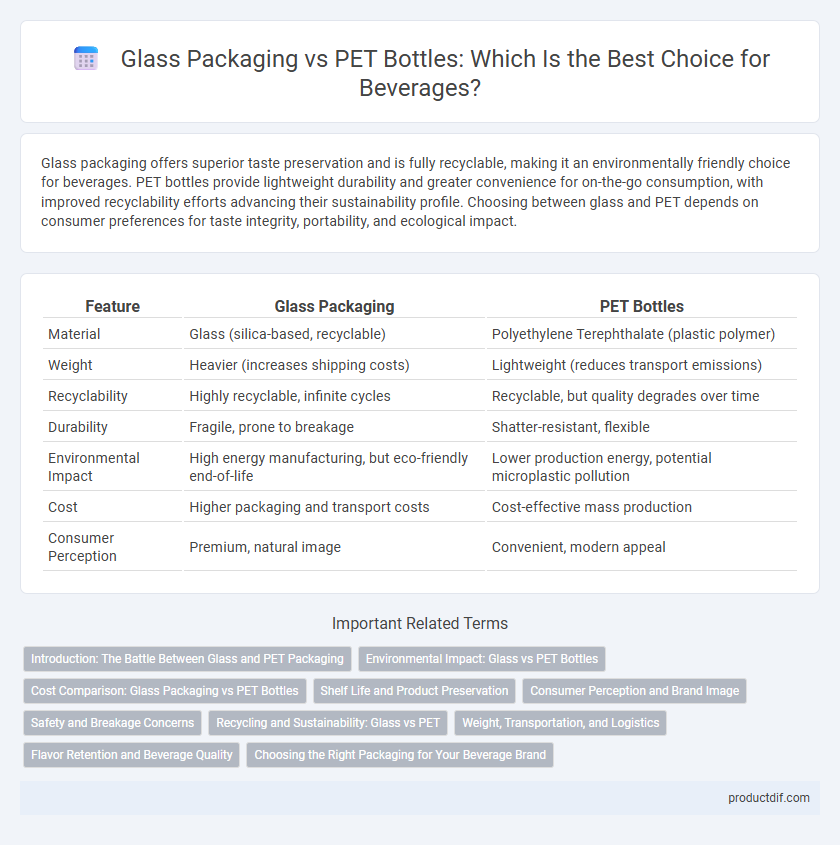Glass packaging offers superior taste preservation and is fully recyclable, making it an environmentally friendly choice for beverages. PET bottles provide lightweight durability and greater convenience for on-the-go consumption, with improved recyclability efforts advancing their sustainability profile. Choosing between glass and PET depends on consumer preferences for taste integrity, portability, and ecological impact.
Table of Comparison
| Feature | Glass Packaging | PET Bottles |
|---|---|---|
| Material | Glass (silica-based, recyclable) | Polyethylene Terephthalate (plastic polymer) |
| Weight | Heavier (increases shipping costs) | Lightweight (reduces transport emissions) |
| Recyclability | Highly recyclable, infinite cycles | Recyclable, but quality degrades over time |
| Durability | Fragile, prone to breakage | Shatter-resistant, flexible |
| Environmental Impact | High energy manufacturing, but eco-friendly end-of-life | Lower production energy, potential microplastic pollution |
| Cost | Higher packaging and transport costs | Cost-effective mass production |
| Consumer Perception | Premium, natural image | Convenient, modern appeal |
Introduction: The Battle Between Glass and PET Packaging
Glass packaging offers superior product preservation and premium aesthetics, maintaining beverage flavor and carbonation while appealing to eco-conscious consumers through its recyclability. PET bottles provide lightweight durability, cost-efficiency, and shatter resistance, making them ideal for on-the-go consumption and high-volume distribution. The choice between glass and PET hinges on factors like sustainability goals, consumer preferences, and the specific beverage type.
Environmental Impact: Glass vs PET Bottles
Glass packaging is highly recyclable and can be reused indefinitely without quality loss, significantly reducing landfill waste and resource consumption. PET bottles, while lightweight and energy-efficient to produce, often contribute to plastic pollution due to lower recycling rates and potential microplastic contamination. Life cycle assessments highlight glass's advantages in sustainability when recycled properly, whereas PET's environmental impact depends heavily on effective waste management systems.
Cost Comparison: Glass Packaging vs PET Bottles
Glass packaging generally incurs higher production and transportation costs due to its heavier weight and fragility, leading to increased energy consumption and handling expenses. PET bottles offer a more cost-effective solution with lower material and shipping costs, benefiting from lighter weight and greater durability. Overall, PET bottles provide significant savings in logistics and manufacturing, making them more economically viable for large-scale beverage distribution.
Shelf Life and Product Preservation
Glass packaging offers superior shelf life for beverages due to its impermeability and inert nature, preventing oxygen and contaminants from affecting flavor and freshness. PET bottles allow for lightweight, shatter-resistant packaging but provide less barrier protection, which can lead to faster degradation and shorter product preservation. For beverages requiring extended shelf life and premium quality maintenance, glass remains the optimal choice.
Consumer Perception and Brand Image
Glass packaging is often perceived by consumers as premium and environmentally friendly, enhancing brand image through its association with quality and sustainability. PET bottles, while favored for convenience and lightweight properties, may be viewed as less eco-friendly but offer greater versatility and cost efficiency. Brands leveraging glass packaging can strengthen consumer trust and loyalty by emphasizing recyclability and product purity.
Safety and Breakage Concerns
Glass packaging offers superior resistance to chemical leaching and provides a non-reactive surface, ensuring beverage purity and safety. PET bottles, while more prone to scratches and micro-cracks, are less likely to shatter than glass, reducing breakage hazards in transport and handling. Safety concerns with glass primarily involve breakage risk, which can lead to injury and product contamination, whereas PET bottles emphasize durability and tamper resistance.
Recycling and Sustainability: Glass vs PET
Glass packaging offers superior recyclability with an infinite recycling loop, maintaining quality and purity without degradation, making it a sustainable choice for beverage containers. PET bottles, while lightweight and convenient, face challenges with recycling efficiency and often degrade in quality after multiple cycles, contributing to plastic waste issues. Prioritizing glass packaging can significantly reduce environmental impact by minimizing landfill contributions and promoting a circular economy in beverage packaging.
Weight, Transportation, and Logistics
Glass packaging is significantly heavier than PET bottles, impacting transportation costs and fuel consumption due to increased weight. PET bottles offer greater flexibility in design, reducing volume and optimizing pallet space, which enhances logistics efficiency and lowers shipping expenses. The lightweight nature of PET bottles enables higher shipment quantities per load, leading to improved distribution speed and reduced carbon footprint compared to glass packaging.
Flavor Retention and Beverage Quality
Glass packaging ensures superior flavor retention due to its non-reactive nature, preventing any alteration in beverage taste or aroma. PET bottles, while lightweight and shatter-resistant, may allow slight oxygen permeation that can affect freshness and overall beverage quality over time. Maintaining product integrity is crucial, making glass the preferred choice for premium beverages prioritizing long-lasting flavor stability.
Choosing the Right Packaging for Your Beverage Brand
Glass packaging offers superior product preservation and is fully recyclable, making it ideal for premium beverages seeking to emphasize quality and sustainability. PET bottles provide lightweight, shatter-resistant convenience and lower transportation costs, suitable for high-volume brands targeting mass-market distribution. Evaluating factors such as target consumer preferences, environmental impact, and supply chain logistics ensures the right packaging choice enhances brand positioning and operational efficiency.
Glass Packaging vs PET Bottles Infographic

 productdif.com
productdif.com